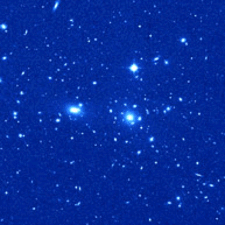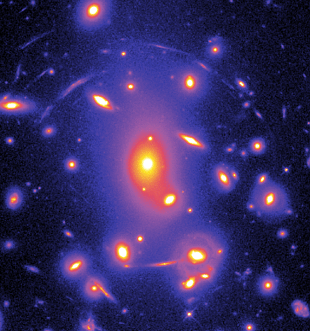Self-Interacting Dark Matter and the Distribution of Matter in Clusters of Galaxies |

|
Figure 1: The Coma cluster of galaxies in optical light. |
By comparing the mass of all the individual galaxies in the Coma cluster with the total mass required for gravity to produce their observed motions, Fritz Zwicky showed in 1933 that most of the mass of the cluster must be in some unknown and invisible form. Nearly seventy years later his conclusion has been confirmed for many other galaxy clusters, and it is now generally believed that the most of the mass in the universe is in some dark form which has still only been detected through its gravitational effects. (Further details are here.) Currently popular models for the formation of structure in the universe assume that this dark matter is made of vast numbers of free elementary particles which are collisionless, that is that they interact with each other and with other matter only through gravity. Recently, Princeton scientists, David Spergel and Paul Steinhardt, proposed an alternative model in which the dark matter particles occasionally collide elastically (like billiard balls) as they move through the cluster. Spergel and Steinhardt argued that this model might agree better than the collisionless model with the inferred amounts of dark matter at the centre of dwarf galaxies.
|
||||||
| Figure 2: Images of the dark matter distribution in our simulated clusters. The top pictures are 50 million light years on a side, while the lower pictures are enlargements of their central regions. In the leftmost simulation the dark matter particles are assumed to be collisionless. In the middle simulation particles near cluster centre have about 10 collisions over the age of the universe, while in the rightmost simulation this number is about 100. The shape and concentration of the cluster are clearly affected by particle collisions. |
Stimulated by this suggestion, we and our collaborators have recently carried out very large computer simulations at the Max-Planck-Institut für Astrophysik (MPA) to study how such elastic collisions between dark matter particles might affect the obervable structure of clusters of galaxies. These calculations were carried out on the T3E supercomputer of the Max-Planck Society's computer centre in Garching (the RZG) using a modified version of the parallel simulation code GADGET. Simulations were carried out for a variety of collision probabilities chosen so that typical particles near the centre of the final cluster have a few, a few tens, a few hundreds or a very large number of collisions over the lifetime of the universe. As the pictures below show, collisions between dark matter particles do indeed affect the structure of the final cluster: more frequent collisions lead to clusters which are rounder and have weaker central concentrations.

|
Figure 3: Space Telescope image of Abell 2218 showing many giant arcs. |
Although the dark matter in galaxy clusters cannot be seen directly, a very direct way to measure its properties is offered by the phenomenon of gravitational lensing. The images of distant galaxies lying far behind the cluster are gravitationally distorted into giant arcs as the light passes through the cluster on its journey to our telescopes. The shapes and positions of these arcs provide a detailed picture of how matter is distributed near the cluster centre. It can be used to tell which, if any, of our simulated dark matter distributions look like real clusters. Detailed modelling of gravitational lensing by our simulated clusters (carried out in collaboration with scientists in Padova, see the reference below) suggests that arcs as strong as those seen in Abell 2218 can only be produced if collisions between dark matter particles are very rare. Even a few collisions per particle over the age of the universe are enough to reduce the effectiveness of cluster lenses to the point where they can no longer produce the dramatic arcs we observe. Lensing thus offers a way to limit (perhaps even to measure) certain intrinsic properties of the dark matter particles.
Naoki Yoshida
und
Simon White
Further reading:
| MPA-Home |